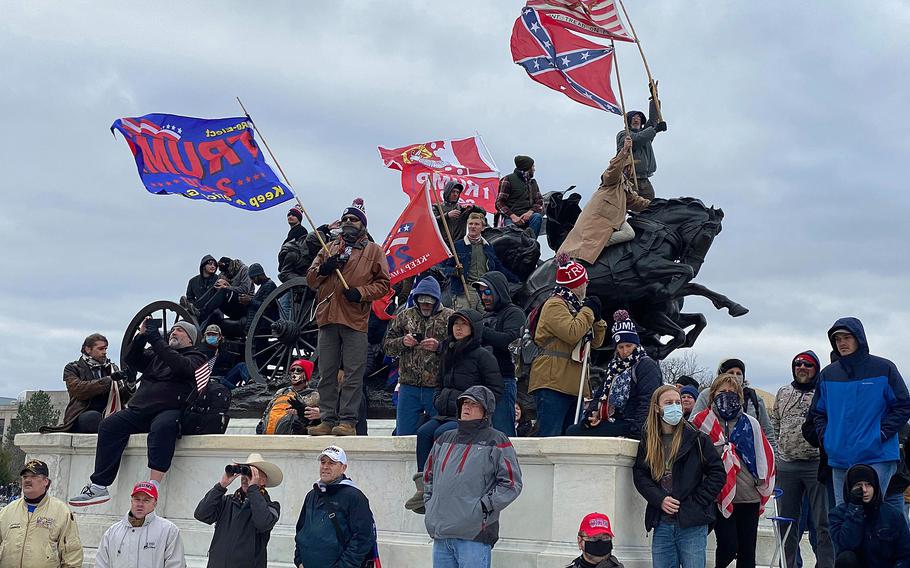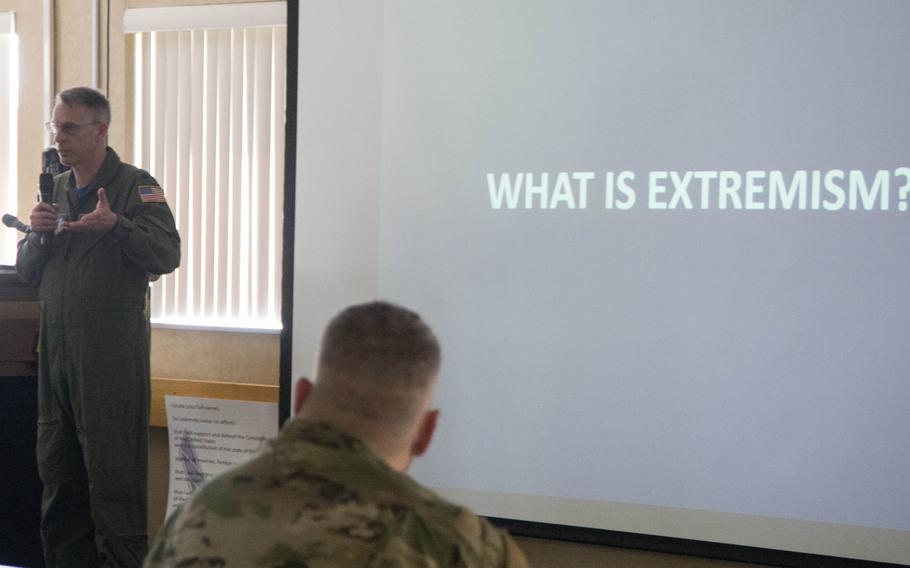
Rioters storm the Capitol in Washington, D.C., on Jan. 6, 2021. A recent study by the Institute for Defense Analyses found that there is no evidence to support the notion that violent extremism is widespread in the U.S. military, though extremism may be rising among veterans. (Robert H. Reid/Stars and Stripes)
Violent extremism isn’t widespread in the U.S. military but may be rising among veterans, according to a new study carried out amid concerns that such influences could be taking root in the force.
The Institute for Defense Analyses was commissioned by the Defense Department to investigate extremism in the ranks following a recommendation from a Pentagon working group formed in the aftermath of the Jan. 6, 2021, riot at the U.S. Capitol.
The assault on the Capitol involved multiple military veterans and active-duty members. That prompted Defense Secretary Lloyd Austin to order a stand-down so commands and units could discuss the issue of extremism in their formations.
The IDA study, released in late December, found no sign that extremism is running amok within the 1.3 million troop-strong active-duty force.
“Racism and sexism continue to be problems in the military, but only a handful of violent extremists have been identified in the military ranks,” stated the report.

Arizona Army National Guard soldiers stand in formation Dec. 3, 2023, in Mesa, Ariz. A recent study by the Institute for Defense Analyses found that there is no evidence to support the notion that violent extremism is widespread in the U.S. military, though extremism may be rising among veterans. (Brian Barbour/U.S. Army National Guard)
The Defense Department has a lengthy definition for extremism, which among other things bars advocating or engaging in unlawful force or violence to achieve goals that are political, religious, discriminatory or ideological in nature.
But service members at all levels told IDA investigators that they were confused about what precisely is prohibited.
“In the absence of a clear and consistent message, there is a risk that misinterpretations could lead to a significant division in the force along political and ideological lines.
“IDA found reason to believe that the risk to the military from widespread polarization and division in the ranks may be a greater risk than the radicalization of a few service members.”
IDA found fewer than 100 substantiated cases per year of extremist activity by members of the military in recent years.
The numbers were similar to those in a separate report compiled by the Defense Department Inspector General in 2021 that identified 92 documented cases of extremist and gang activities between January and September of that year.
The IDA report also examined the prevalence of extremist and gang-related activity reflected in court-martial opinions, finding fewer than 20 such cases since 2012. When gang cases are excluded, the total number of extremist cases amounted to one per year over the period studied, IDA said.
“The extremely low number of published court-martial cases involving prohibited extremist activities appears consistent in overall scale with the relatively low number of cases tracked in DOD criminal and investigative data systems,” the report said.
Meanwhile, the IDA study determined that extremism among veterans “appears to be on the increase” and that they could be vulnerable to recruitment.

Air Force Lt. Col. Kevin Culbert defines extremism during a briefing in Martinsburg, W.Va., as part of a 2021 stand-down ordered by Defense Secretary Lloyd Austin. A recent study by the Institute for Defense Analyses found that there is no evidence to support the notion that violent extremism is widespread among the troops, but that extremist groups have been known to target veterans. (Mallory Coleman/U.S. Air Force)
“Extremist organizations have been known to target veterans as they separate from service and transition to civilian life,” the report said. “Former service members can be particularly vulnerable to extremist organizations that appear to offer a continuation of the camaraderie and shared identity and connectedness that individuals experienced while serving in uniform.”
Still, other studies have shown that extremism in the veteran community could be even lower than among most other Americans.
For example, a Rand Corp. report in May found that military veterans expressed support for far-left movements and white supremacist groups at lower rates than the general U.S. population.
But the IDA report noted that participation in violent extremist activities by only a small number of people with military connections can damage trust in the institution. Therefore, it presents “a risk to the military and to the country as a whole.”
The report made 18 recommendations, which included further development of the definition of what constitutes prohibited extremist activities to ensure that the behavior is consistently defined across the military.
The report also cautioned that the military needs to differentiate between individual offenses of prejudice, harassment and bullying and cases of prohibited extremist behavior.
“Not all misconduct is extremist and reporting individual incidents as prohibited extremism may give a distorted picture of the role and influence of extremist groups in the Department,” the report said.